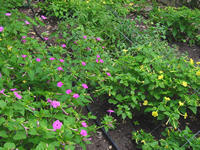Search
For The Answer
Click here to access our database of
Plant Answers
Search
For The Picture
Click here to access the Google database of plants
and insects
Information
Index
Alphabetical Listing of Topics, Recommendations
and Plants
Milberger's Nursery and Landscaping
3920 North Loop 1604 E.
San Antonio, TX 78247
210.497.3760
nursery@milbergersa.com
Open 9 to 6 Mon. through Sat.
and 10 to 5 on Sun.

Three exits east of 281, inside of 1604
Next to the Diamond Shamrock station
Please click map for more detailed map and driving directions.


Four o'clocks For
Fragrance
please click on any image
to enlarge
|
1) flourish in periods of severe drought and water restrictions, i.e., listed among the most drought tolerant : Cockscomb, Coreopsis, Cosmos, Four o'clock, Moss Rose, Petunia, Purslane, Verbena, Zinnia (2) will bloom in less than full sunlight situations, i.e., listed among the most Shade or Semi-Shade Tolerant: Begonia, Bellflower, Coleus, Dwarf Lobelia, Four O'CLOCK, Flowering Tobacco, Impatiens (3) is deer and rabbit tolerant in that it is not a preferred plant for deer and can recoup rapidly after being damaged by deer, dogs, and other varmints, (4) is fragrant, (5) is a long-lived tuberous perennial and reseeding annual, and (6) is one of a very few hummingbird and butterfly plants for shady growing conditions. The skeptics may wonder why this wonderful plant has not been promoted before now. The simple answer is that this plant is so adapted and tenacious, it is sometimes considered invasive, i.e., one person's trash is another person's treasure OR familiarity breeds discontent. Or maybe it is because the flowers do not stay open all day -- flowers are not responding to an internal clock but to temperature so the flowers open in the afternoon, about 4 o'clock. Usually, the flowers close the following morning, but if the day is cool, they will stay open until the new flowers open. In the Hellish summer temperatures of Texas, folks can only enjoy their flowers in the late evening anyway and four o'clocks provide beauty and fragrance during that cooler time of the day. Flowers are trumpet-shaped, with the throat as much as 2 inches long and 1 inch wide with five lobes. Flowers are produced in shades of white, yellow and about every shade of pink imaginable. The striped flowers appear to be infected with a virus disease that creates the interesting patterns. The flower is an enigma in that it completely lacks petals. The showy portion of the flower is actually an outgrowth of the sepal, which in most plants is green and leaf-like. The small leafy structure from which the flower emerges is made of bracts formed from modified leaves. The absence of petals is rare in the plant kingdom. Each flower that is pollinated produces a pea-size black "seed." The seed is not really a seed but a fruit. A true seed is produced inside something -- for example, inside a pea pod or the capsule of a petunia. In this case, each flower produces one seed that is enclosed inside the ovary. So, in reality the "seed" is a "fruit." Greg Grant of PLANTanswers.com Arcadia Archives and former Bexar County Extension Horticulturist writes that he dug the root of one he found in a little abandoned yard that was dark hot pink and grew it for a year before he realized it had NO fragrance. Greg's granny's plant had blooms that had a fragrance as sweet as sugar! Greg has provided us with a fragrant yellow-blooming plant from his Granny Ruth. The Four o'clock name is a misnomer. The name Mirabilis was given by Linnaeus in the middle 18th Century and shortened from the Latin word "Admirabilis" which gives us "admirable" and is a reference to the showy flowers. The name "jalapa" is due to botanical confusion. The fleshy roots of this plant were thought to be the source of "jalapa," a drug that was used in Central and South America as a laxative. In reality, the jalapa was from a member of the morning glory family. The common name -- Four o'clock -- is one of our oldest garden flowers and was originally shipped back to Europe by the Spanish conquistadors. The flowers are fragrant and produce a subtle and delightful fragrance during the early evening hours when the wind is not blowing. Hummingbirds and lunar moths both seem to like to visit the flower for the abundance of nectar. The Four o'clock -- also know as Belle De Nuit Blanche, Belle De Nuit Rose, Belle De Nuit, Buenas Tardes, Dondiego De Noche, Gecesefase, Geje Safa, Gulabbas, Heft Reng, Jalap, Lala A'Bbas, Maravilla, Noche Buena, Tzu Mo Li, Bunga pukul empat, Kederat, Kembang pagi sore, Kembang pukul, Nodja, Segerat, Ubat jerawat -- also has the medicinal uses, actions and properties of antifungal, antimicrobial, antiviral, antibacterial, diuretic, alterative, carminative, cathartic, hydragogue, purgative, stomachic, tonic and vermifuge. The phytochemicals it contains are: 12-TRIACONSANONE, ARABINOSE, BETA-AMYRIN, BETA-AMYRIN-ALPHA-L-RHAMNOSYL-O-BETA-D-GLUCOSIDE, BETA-SITOSTEROL-BETA-D-GLUCOSIDE, N-HEXACOSANOL, TRIGONELLINE. Its ethnobotanical uses are: abscess, alterative, boil, bruise, carbuncle, carminative, cathartic, colic, cosmetic, diabetes, diuretic, dropsy, gonorrhea, hepatitis, herpes, hydragogue, hypochondria, itch, liver, pimple, purgative, rash, repellant (insect), sore, splenitis, stomachic, strain, tonic, tumor, urticaria, uterosis, vermifuge and wound. |


